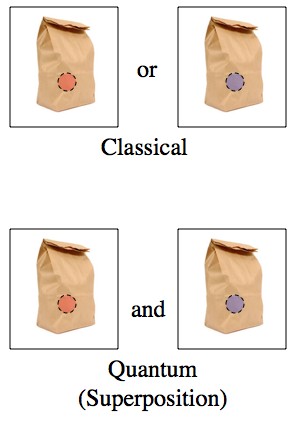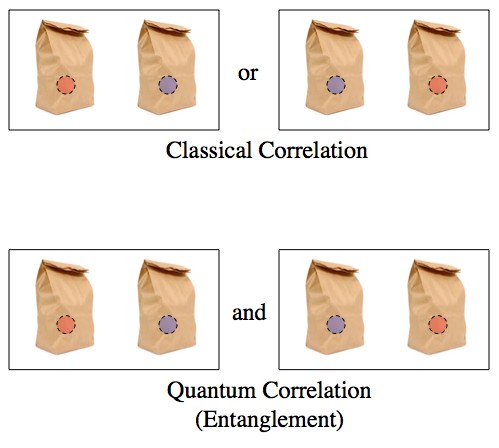Physicist: If all you had access to was the remaining particle, you’d never know the difference.
The way entanglement is often described in popular media makes it sound like voodoo; there’s some kind of magical connection between two or more particles, and doing something to one instantly affects the other. From this point of view it might seem as though you could learn something about the inside of black holes by dropping entangled particles into them, or maybe the outside particle would start acting black-hole-ish.
In practice (reality), entangled particles don’t have any kind of connection with each other, they’re just correlated in a funny way. In quantum physics things can be in multiple states, such as being in multiple places or multiple energy levels. This is called a “superposition“. In classical physics things can only be in one state (I can’t tell you where my keys are, but they’re definitely not in more than one place).
So, say I’ve got some paper bags and one red and one blue marble. Classically, the marble is either red or blue, but not both. In quantum mechanics you could prepare a state that’s a superposition of red and blue.

Top: the marble is definitely either red or blue.
Bottom: the marble can be in a superposition of red and blue.
Oddly enough, you can’t describe the world by describing the state of each particle individually. You have to include states that involve multiple particles that are in multiple states. Bringing a second bag into the picture, and putting one of the two marbles into each, we find that there are two possible states: red/blue and blue/red. In quantum mechanics, there’s no problem having a combination of these two states as well. Notice that since there’s only one marble of each color, the bags are correlated; if you know what’s in one, then you know what’s in the other.

Top: if one bag has a red marble, the other has a blue and vice versa.
Bottom: if one bag has a red marble, the other has a blue and vice versa. However, both bags have both red and blue. In the same way that a single particle can be in multiple states, the bags together are in the states “red/blue” and “blue/red”.
There’s more detail about what exactly entanglement is and how it behaves here, but suffice it to say, when things are correlated and in a superposition of states they’re entangled. So finally, with that background we can take a look at what happens when you destroy or just take away half of an entangled pair.
A black hole, in addition to all of its other weird properties, does a really good job doing exactly that. For all practical (experimental) purposes, dropping a particle into a black hole destroys it plenty. By watching the black hole afterward, it would be impossible to recover information about the one particle you dropped in. So, what you’re left with is a single particle that’s still in a superposition of states.

Destroying or sufficiently scrambling half of an entangled pair leaves a single particle in a not-entangled superposition.
This, by the way, is what you have even if you don’t destroy the other particle. Without access to both halfs of an entangled pair, there’s no way to determine if they’re entangled at all.
There was a big debate between some of physic’s heavyweights over whether or not things that fall into black holes are genuinely destroyed, including all of their information, or if information is somehow preserved. After a few decades of debate, the consensus today is: no, information is conserved. This has lead to some new ideas like black hole entropy, Hawking radiation, holography theory, and black hole computation (this last one is a little more far-fetched than the others). In theory, if you somehow managed to keep track of absolutely every detail of everything that fell into the black hole, and then managed to collect most of the Hawking radiation produced by the black hole over its entire life time (which is much, much greater than the age of the universe), then you could in theory have a pretty good chance of correctly guessing which “marble” fell in.
But, for all intents and purposes, if you have an entangled pair of particles and you drop one into a black hole, you’ll be left with one particle that is still technically entangled to the other, but it doesn’t matter. It’ll behave like any other particle.
Answer gravy: There are buckets more to be said about breaking entanglement, and the statistics of entangled pairs (and halfs of entangled pairs), including the exact nature of the superposition of the remaining particle. Way too many buckets to fit into one article. However! There’s a great resource that goes into ludicrous detail here. The stuff relevant to this post is in chapter 4.







19 Responses to Q: Two entangled particles approach a black hole, one falls in and the other escapes. Do they remain entangled? What about after the black hole evaporates?